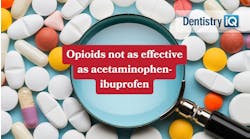By Leslie Canham, CDA, RDA
Each leak is counted as a defect.As dental health-care providers, we wear gloves every day for all dental procedures. How reliable are gloves when it comes to protecting our hands? This article will cover how gloves are regulated and give tips to maximize glove performance to ensure hand protection.Do exam gloves fully protect hands? According to the Centers for Disease Control and Prevention (CDC), limited studies of the penetrability of different glove materials under conditions of use have been conducted in the dental environment. Consistent with observations in clinical medicine, leakage rates vary by glove material (e.g., latex, vinyl, and nitrile), duration of use, the type of procedure performed, and manufacturer. The frequency of perforations in surgeon’s gloves during outpatient oral surgical procedures ranges from 6% to 16%. Studies have demonstrated that dental health-care providers are frequently unaware of minute tears in gloves that occur during use. These studies determined that gloves developed defects in 30 minutes to three hours, depending on the type of glove and procedure.1How are examination gloves tested? The Food and Drug Administration (FDA) sets guidelines by enforcing a set of test methods called American Society for Testing and Materials (ASTM). All medical gloves must meet certain Acceptable Quality Level (AQL) standards. AQL is used by manufacturers to identify the maximum number of allowable defects (pinholes) per 100 gloves. A lower AQL number represents a higher quality product. The AQL score is calculated by the number of defective gloves per 100 tested. An AQL requirement of 4.0 means that out of every 100 gloves tested for pinholes, there must be fewer than four defective gloves. The lower the AQL score, the higher the quality of the medical gloves. One way to measure AQL for gloves is the “water test.” The water test is conducted by filling the glove with 1,000 ml of water, suspending the glove for two minutes, and then looking for any leaks. Each leak is counted as a defect. Another method to inspect gloves is called the “air inflation test,” which is inflating the glove with air and visually inspecting it for holes. The AQL requirement for examination gloves was previously 4.0. The FDA changed the requirement to 2.5 AQL, which means for every 100 gloves tested, fewer than 2.5 gloves can be defective. More rigorous standards are applied to surgeon’s than to examination gloves. The FDA has identified acceptable quality levels (e.g., maximum defects allowed) for glove manufacturers, but even intact gloves eventually fail with exposure to mechanical (e.g., sharps, fingernails, or jewelry) and chemical (e.g., dimethyacrylates) hazards over time.1Does wearing gloves eliminate the need for hand washing?Wearing gloves does not eliminate the need for hand washing. Hand hygiene should be performed immediately before donning gloves and every time gloves are removed. Because gloves can have small, unapparent defects or can be torn during use, hands can become contaminated. Bacteria can multiply rapidly in the moist environment underneath gloves, and thus, the hands should be dried thoroughly before donning gloves and washed again immediately after glove removal.Other things to keep in mind:Washing latex gloves with plain soap, chlorhexidine, or alcohol can lead to the formation of glove micro punctures and subsequent hand contamination. Because this condition, known as wicking, can allow penetration of liquids through undetected holes, washing gloves is not recommended.1To maximize glove performance and prevent punctures or tears:
- Maintain short fingernails
- Minimize or eliminate hand jewelry
- Use engineering and work practice controls
- Change gloves as soon as possible if the integrity of the glove is compromised
- Avoid using hand lotions that have petroleum or mineral oil products
- Allow hands to dry completely before donning gloves
- Allow alcohol hand sanitizers to dry thoroughly before donning gloves
- Avoid storing gloves in direct sunlight and where there is moisture/high humidity
Author bio
Leslie Canham is a dental speaker and consultant specializing in infection control and OSHA compliance. She has more than 36 years of experience in dentistry. Canham is the founder of Leslie Canham Seminars, providing in-office training, mock inspections, consulting, and online seminars and webinars to help the dental team navigate state and federal regulations. Reach Canham at (888) 853-7543 or Leslie Canham.
Reference
1 Centers for Disease Control and Prevention. Guidelines for Infection Control in Dental Health-Care Settings 2003. MMWR 2003; 52(No. RR-17):18-19.







